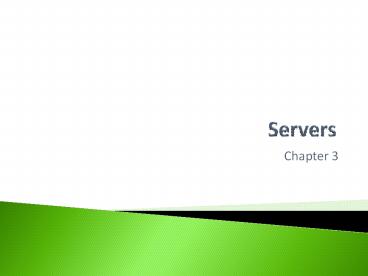Servers PowerPoint PPT Presentation
1 / 10
Title: Servers
1
Servers
- Chapter 3
2
This presentation will
- Help you understand different types of servers
commonly found on a network including - File Server
- Application Server
- Mail Server
- Proxy Server
- Print Server
- Backup Server
3
File server
- Stores user data files.
- Network Operating System (NOS) allows accounts to
be set up. - Requires username and password.
- Can only access your own files.
4
Application Server
- Stores applications for use across networks.
- The application server can be used in two ways
- For storing installation files which can easily
be deployed across client machines. - Low network traffic but increase in required
processing power at client side. - Allows applications that are installed on the
server to be run by client from the server side. - High network traffic but less demand on
processing at client side.
5
Mail server
- Manages mail in and out of a network.
- Checks income emails for viruses
- Filters out SPAM emails
- Provides central address book for the
organisation - Sets email and inbox sizes
- Useful for both internal and external email.
6
Proxy server
- Used to cache web pages.
- When a request is made to a web server, a web
page is downloaded and displayed on the clients
computer. It is also stored or cached on the
proxy server. - Requests for the same page are then downloaded
from a proxy server which is much quicker than
downloading from the internet.
7
Proxy server (cont.)
- Also act as a security buffer.
- Clients make a request for a file on a file
server. - The proxy intercepts the request and checks the
clients authenticity. - Checks validity of user and they have
authorisation to receive a file. - Proxy then requests the file from the file server
and forwards it back to the client. - The client never has direct access to the file
server.
8
Print server
- Allows access to a shared printer.
- Usually come with spooler software.
- Spoolers collect jobs that have been sent to a
printer, puts them in a queue, and then forwards
the print queue to the printer. - Printers work much slower than a computer. This
is why we use a spool. - Computers would slow down if each file was sent
to a printer as the computer would have to wait
for the printer to catch up with it.
9
Backup Server
- The backup server backs up all data on the
network. - If all users save data on the server, the server
can automatically back-up files over night. - This means that if data is lost it can be
recovered. - It may not be the most up to date version but it
is better than having to start again. - It will usually make use of tape drives.
10
Activity
- Describe the following servers
- A file server
- A print server
- A CD-ROM server
- A mail server
- A web server
- A proxy server
- Remember Identify, Amplify and Exemplify

